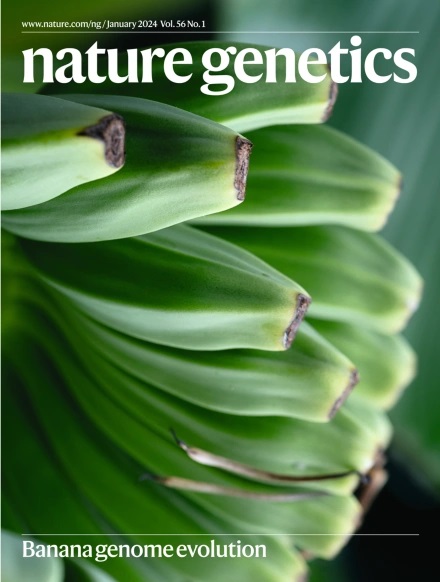嗜色枯病相关的21号染色体扩增通过DYRK1A的靶向过表达协调转化为爆发期MPN
IF 31.7
1区 生物学
Q1 GENETICS & HEREDITY
引用次数: 0
摘要
染色体断裂,染色体的混乱破碎和修复,在癌症中很常见。嗜色thripsis是否产生可行的治疗靶点仍然是一个悬而未决的问题。在一组64例骨髓增殖性肿瘤(BP-MPN)的母细胞期患者中,我们描述了染色体21q (' chr)区域的复发性扩增。25%的患者为21amp '),其中三分之一的患者是由染色体断裂引起的。我们报道。BP-MPN具有特别具有侵袭性和治疗抗性的表型。DYRK1A是一种丝氨酸苏氨酸激酶,是2.7兆碱基最小扩增区中唯一一个与非chr相比表达和染色质可及性都增加的基因。21安培BP-MPN控制。DYRK1A是BP-MPN发育过程中多种细胞功能联系的中心节点,对BP-MPN细胞体外和体内增殖至关重要,并代表一个可药物轴。总的来说,这些发现定义了chr。21amp作为BP-MPN的预后生物标志物,并将染色体裂解与治疗靶点联系起来。本文章由计算机程序翻译,如有差异,请以英文原文为准。


Chromothripsis-associated chromosome 21 amplification orchestrates transformation to blast-phase MPN through targetable overexpression of DYRK1A
Chromothripsis, the chaotic shattering and repair of chromosomes, is common in cancer. Whether chromothripsis generates actionable therapeutic targets remains an open question. In a cohort of 64 patients in blast phase of a myeloproliferative neoplasm (BP-MPN), we describe recurrent amplification of a region of chromosome 21q (‘chr. 21amp’) in 25%, driven by chromothripsis in a third of these cases. We report that chr. 21amp BP-MPN has a particularly aggressive and treatment-resistant phenotype. DYRK1A, a serine threonine kinase, is the only gene in the 2.7-megabase minimally amplified region that showed both increased expression and chromatin accessibility compared with non-chr. 21amp BP-MPN controls. DYRK1A is a central node at the nexus of multiple cellular functions critical for BP-MPN development and is essential for BP-MPN cell proliferation in vitro and in vivo, and represents a druggable axis. Collectively, these findings define chr. 21amp as a prognostic biomarker in BP-MPN, and link chromothripsis to a therapeutic target. Multiomic analysis of blast-phase myeloproliferative neoplasms identifies a chromosome 21 amplicon harboring DYRK1A as a clonal and therapeutically targetable event in around a quarter of cases.
求助全文
通过发布文献求助,成功后即可免费获取论文全文。
去求助
来源期刊

Nature genetics
生物-遗传学
CiteScore
43.00
自引率
2.60%
发文量
241
审稿时长
3 months
期刊介绍:
Nature Genetics publishes the very highest quality research in genetics. It encompasses genetic and functional genomic studies on human and plant traits and on other model organisms. Current emphasis is on the genetic basis for common and complex diseases and on the functional mechanism, architecture and evolution of gene networks, studied by experimental perturbation.
Integrative genetic topics comprise, but are not limited to:
-Genes in the pathology of human disease
-Molecular analysis of simple and complex genetic traits
-Cancer genetics
-Agricultural genomics
-Developmental genetics
-Regulatory variation in gene expression
-Strategies and technologies for extracting function from genomic data
-Pharmacological genomics
-Genome evolution
 求助内容:
求助内容: 应助结果提醒方式:
应助结果提醒方式:


